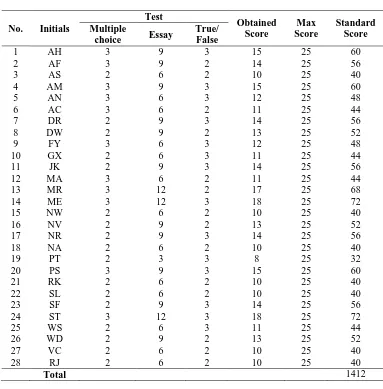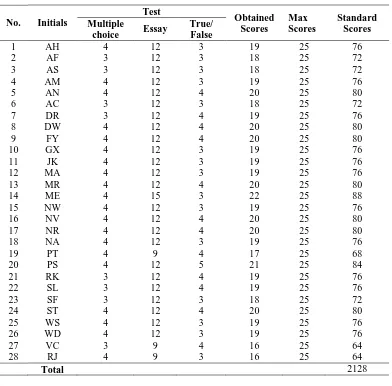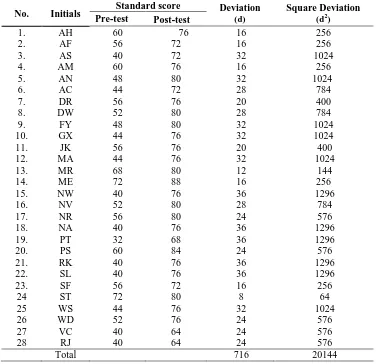e-Journal of English Language Teaching Society (ELTS) Vol. 3 No. 2 2015 – ISSN 2331-1841 Page 1
THE USE OF GUIDED READING
TO IMPROVE READING COMPREHENSION
OF THE EIGHTH GRADE STUDENTS
Ni Gusti Ayu Eni Puspitawati1, Mochtar Marhum2, Wahyudin3
Abstract
The objective of the research was to find out whether the use of guided reading can improve reading comprehension of the eighth grade students of SMP Negeri 12 Palu or not. The research used a pre-experimental research design. The sample was the students of Class VIII A consisting of 28 students selected by using a purposive sampling. The test was distributed twice as a pre-test and a post-test. The data from the tests were analyzed statistically. After analyzing the data, the researcher found that the result of the mean score of the pre-test was 50.42 and the post-test was 76. By applying 0.05 level of significance with the degree of freedom (d.f.) 27 (N – 1= 28 – 1= 27), the researcher found that the t-counted value (16.49) was greater than the t-table value (1.703). It means that the hypothesis was accepted. In conclusion, the use of guided reading can improve the reading comprehension of the eighth grade students of SMP Negeri 12 Palu.
Keywords: Guided Reading; Improving; Reading Comprehension
INTRODUCTION
Reading is one of the basic language skills that is very important for the students to learn in order to get much information or improve their knowledge. Tarigan (1998) states that reading is a process done and used by the reader to get message sent through written media. It means that through reading, someone will get information or messages needed. Comprehension is involved in reading process. Reading comprehension is a complex process in which the readers have to apply their mental content to get or to understand the meanings from written texts. The readers must also be able to comprehend the text in order to show their understanding by expressing the content of the text. The way to express the content is by answering the question given from the text. It means when the readers have ability to answer the question correctly, it can be concluded that they are successful in comprehending the text. Ohoiwutun (2005:5) states, “In order to read actively and to comprehend what you read, you must ask question about your sources and try to answer them.”
1
Prodi Pendidikan Bahasa Inggris FKIP Universitas Tadulako - email: [email protected] 2
email: [email protected] 3
e-Journal of English Language Teaching Society (ELTS) Vol. 3 No. 2 2015 – ISSN 2331-1841 Page 2
There are several kinds of reading techniques to improve reading comprehension. Some of them are skimming and scanning. Skimming is a technique used when the reader wants to know the main idea of the text. According to Abela (2004), skimming is mainly used when researching and getting an idea of the text. Skimming is also defined as the process of reading to get the most important information or the main ideas in the passage. When using skimming text, the readers do not need to read word by word to get the main idea. They should know the position of the main idea. Mostly, it is put in the first sentence in paragraph, but main ideas appear in elsewhere in the paragraph as well. Scanning is another technique in reading. Scanning is the ability to look for or to find some specific information as quick as
possible. It is supported by Kustaryo (1988:90), “When students need to locate specific
information, she/he might be able to scan or to find the information they need”. Through this technique, the students are also trained to move their eyes rapidly to find out the information needed.
The researcher conducted the research at SMP Negeri 12 Palu. She found that the students got difficulties in some cases. Firstly, they have lack of vocabulary. Most students only read a text without understanding what the content of the text is. As the result, the students do not get anything of what has been read. Secondly, they fail to catch the meaning of word in the text. They do mistakes because many words have more than one meaning which makes the students confused to find out the meaning. Finally, the students usually complain about the length of the text provided by the teacher. As the result, the students get bored to this subject.
The limitation of the research is needed to make the research specific. The researcher
focused on her research on improving the students’ reading comprehension through guided
e-Journal of English Language Teaching Society (ELTS) Vol. 3 No. 2 2015 – ISSN 2331-1841 Page 3
Based on the explanation above, the researcher formulated a research question as follows: “Can the use of guided reading technique improve the reading comprehension of the
eighth grade students of SMP Negeri 12 Palu?”. The objective of this research was to find out whether the use of guided reading technique can improve the ability of the students in comprehending the English text or not.
METHODOLOGY
In conducting the research, a pre-experimental research design was used. The pre-test was given to find out the students’ reading comprehension before the treatment. Then, the researcher treated the students through guided reading technique. Finally, the post-test was given to measure the effectiveness of this technique. The design of this research is proposed by Creswell (2009:160) as follows:
01 X 02
Where : 01 =pre-test X = treatment 02 = post-test
Population is the object of the research. According to Gay (1996:112), “The population is the group of interest to the researcher, the group which she or he would like to the results of the study to be generalizable. The defined population has at least one characteristic that differentiates from other groups”. Thus, the population of this research was the eighth grade students of SMP Negeri 12 Palu, having two parallel classes. They were Class A (Radensaleh) consisting of 28 students and Class B (Kartini) consisting of 26 students. The total number of the students was 54. Creswell (2005:146) defines, “A sample is a subgroup of the target population that the writer plans to study for generalizing about the
target population”. In taking the sample, the researcher used purposive sampling technique
because it was suitable for the design of the research. The sample of this research was Class VIIIA (Radensaleh) consisting of 28 students.
Concerning to the title of the research, the researcher used two kinds of variables. They are dependent variable and independent variable. The dependent variable was the students’ achievement in reading comprehension, while the independent variable was the use of guided reading technique.
e-Journal of English Language Teaching Society (ELTS) Vol. 3 No. 2 2015 – ISSN 2331-1841 Page 4
was in the form of written test consisting of pre-test and post-test. In administering the test to the students, the researcher employed the scale of scoring system:
Table 1. The Scoring System of the Test
No. Test Items Score of Items Maximum Scores
1. Multiple Choice 5 1 5
2. Essay Test 5 3 15
3. True/false 5 1 5
Total 15 25
After administering the pre-test, the researcher offered a treatment for eight meetings. The meeting was applied based on the English subject scheduled at the school. After the researcher did the teaching process, the post-test was given as the last activity. The purpose of doing this test was to clarify and explain whether the treatment was effective or not by looking at the difference between the pre-test and the post-test.
To find out the ability of the students in comprehending the text, the researcher analyzed the data by calculating the students’ standard score with the students’ answers in the pre-test and post-test. Firstly, the researcher computed the students’ individual score by using the formula recommended by Arikunto (2006:308).
Σ
=
��
x
100Where :
Σ = standard score � = raw score
�
= maximum score100 = constant number
Secondly, the researcher computed the students’ mean score by using formula stated by Arikunto (2006:306).
= ��
Where:
= mean score
e-Journal of English Language Teaching Society (ELTS) Vol. 3 No. 2 2015 – ISSN 2331-1841 Page 5
Thirdly, the researcher computed the mean score of the differences of the pre-test and the post-test based on formula proposed by Arikunto (2006:250).
Md = ��
Where:
Md = mean deviation of pre-test and post test
��
= sum of deviationN = number of students
Fourthly, the researcher computed the square deviation by using formula proposed by Arikunto (2006:276).
��
2�
=��
2–
(��)2Where:
��
2�
= sum of square deviation��
= sum of deviation N = number of studentsFinally, after getting the mean of the pre-test and the post-test, the researcher analyzed the effectiveness of the treatment in order to find out whether the research hypothesis is accepted or rejected. The researcher applied the formula designed by Arikunto (2006:249).
Where :
t = the value of t-counted
Md = mean deviation of pre-test and post-test difference Σx2
d = sum of square deviation N = number of students 1 = constant number
FINDINGS
The researcher conducted the pre-test on November 5th, 2014. The result of the pre-test is presented in the following table.
Based on the table 2, the researcher found that the students’ pre-test was good. The highest score was 72 and the lowest one was 32. After getting the total score of the students, the researcher computed the students’ mean score by using the formula below.
t
= �e-Journal of English Language Teaching Society (ELTS) Vol. 3 No. 2 2015 – ISSN 2331-1841 Page 6
=
��=
141228
=
50.42Table 2. The Result of Pre-test
No. Initials
From the above result, it can be concluded that the students’ mean score in the pre-test
was 50.42. After the researcher conducted the treatment, the students’ post-test results are shown as follows.
After doing the computation, the researcher found that the highest score is 88 and the lowest score is 64. Then, the researcher calculated the mean score of the post-test by using the formula below.
=
��=
2128e-Journal of English Language Teaching Society (ELTS) Vol. 3 No. 2 2015 – ISSN 2331-1841 Page 7
=
76Table 3. The Result of Post-test
No. Initials
From the calculation above, it shows that there are different results in reading comprehension
between the students’ mean score in the pre-test and the post-test. The students’ mean score
in the post-test (76) was greater than students’ mean score in the pre-test (50.42). Those show that students’ achievement greatly increased after the treatment.
After getting the mean score of the pre-test and the post-test, the researcher continued to count the mean deviation and the square deviation. The result is presented in the following table.
e-Journal of English Language Teaching Society (ELTS) Vol. 3 No. 2 2015 – ISSN 2331-1841 Page 8
Table 4. The Deviation of Pre-test and Post-test
No. Initials Standard score Deviation
(d)
e-Journal of English Language Teaching Society (ELTS) Vol. 3 No. 2 2015 – ISSN 2331-1841 Page 9
= 1834.86
After having the sum of square deviation, the researcher needs to analyze the data statistically in order to find out the significant difference of the pre-test and the post-test score by using t-test formula as follows.
t = Md
Σx 2 d N (N−1)
t = 25.57 1834 .86 28 (28−1)
t = 25.57 1834 .86
756
t = 25.57 2.42
t = 25.57 1.55
t = 16.49
After analyzing the data of the test, the researcher found that the result of the data analysis shows that the t-counted is 16.49 by applying 0.05 level of significance with the degree of freedom (df) 27(N-1=28-1=27). The researcher found that the t-counted (16.49) is greater than t-table (1.703). It could be concluded that the research hypothesis is accepted. In other words, guided reading is effective to improve reading comprehension of the eighth grade students of SMP Negeri 12 Palu.
DISCUSSION
The researcher limited her research on improving the students’ reading comprehension by using guided reading technique. The standard score at the school is 60. Based on the result
of the students’ pre-test, only six students get good score. The percentage of the students’
pre-test error in multiple-choice is 60.71%. The percentage of the students’ pre-test error in
essay is 3.57% while the percentage of the students’ pre-test error in true/false statement is
e-Journal of English Language Teaching Society (ELTS) Vol. 3 No. 2 2015 – ISSN 2331-1841 Page 10
To solve the problem, the researcher applied guided reading technique in order to
improve students’ reading comprehension. In the first treatment, the researcher divided the
students into some small groups. Then, the researcher distributed the same topic for all groups and gave instruction how the students do the exercise. The researcher asked the students to discuss it in groups. During the discussion, the researcher observed and guided the students and helped them when they find difficulties in discussing the text. Finally, the researcher asked the students to make a report about the topic discussed by answering the question correctly. For each meeting, the researcher gave the students different topic to discuss. It aimed at improving their reading comprehension through guided reading technique.
After conducting the treatment, the researcher gave the post-test. The researcher found that the students already understood how to answer the question correctly. The percentage of
the students’ error in the post-test especially in multiple-choice is 28.57%. The percentage of
the students’ post-test error in essay is 10.71%. The percentage of the students’ post-test error
in true/false statement is 53.57%. In the post-test, the percentage of students who got the score more than 60 is 100%. There is 1 student (3.5%) who got good score and there are 2 students (7.1%) who got lower score.
Having the problem in reading, the researcher related to the previous study that has been mentioned clearly from Lumira (2012). She applied pre-experimental research design.
The researcher focused on students’ skill in reading narrative text. The instrument of data
collection was a test including the pre-test and the post-test. She found some factors that were difficult for students in reading skill such as having no interest to read the text, being difficult to pronounce the word, and having lack of vocabulary. In short, after applying the treatment, the researcher found that the students’ score was increased. By comparing the result of the pre-test and the post test, the researcher concluded that guided reading technique can develop
students’ skill in reading narrative text. Based on the fact above, the researcher believes that
the use of guided reading technique is effective to improve reading comprehension of the eighth grade students of SMP Negeri 12 Palu.
CONCLUSION AND SUGGESTION
e-Journal of English Language Teaching Society (ELTS) Vol. 3 No. 2 2015 – ISSN 2331-1841 Page 11
hypothesis which the t-counted (16.49) is greater than the t-table (1.703). It means that the research hypothesis is accepted.
Based on the conclusion, the researcher would like to give some suggestions for English teachers, students and other researchers. Firstly, English teachers should use guided reading technique in teaching reading in order to improve students’ reading comprehension. Secondly, this technique can be one of the ways in improving students’ comprehension in reading. Finally, other researchers can use guided reading as a technique in their research.
REFERENCES
Abela. (2004). Definition of Skimming. Retrieved on January 26, 2014 from www.24explore.com.
Arikunto, S. (2006). Prosedur Penelitian Suatu Tindakan Praktek (Edisi Revisi VI). Jakarta: PT. Rineka Cipta
Creswell, J. W. (2005). Educational Research: Planning, Conducting, and Evaluating Quantitative and Qualitative Research (2nd ed.). New York: University of Nebraska Creswell, J. W. (2009). Research Design: Qualitative, Quantitative, and Mixed Methods
Approaches (3rd ed.). California: Sage.
Gay, L. R. (1996). Educational Research. New Jersey: Prentice Hall, Inc.
Kustaryo, S. (1988). Teaching Reading for College Students. Jakarta: Depdikbud-P2LTK Lumira, S. (2012). Developing the Skills of the Eighth Year Students of SMPN 19 Palu in
Reading Narrative Text through Guided Reading. Unpublished Skripsi. Palu: Tadulako University.
Ohoiwutun, J. E. (2005). Extensive Reading I & II : Task for Skills and Strategies Development. Palu: Tadulako University. Unpublished.



